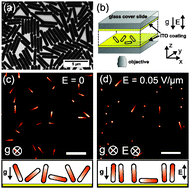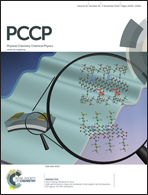Orientation of a dielectric rod near a planar electrode
Abstract
We present experimental and theoretical results on suspensions of silica rods in DMSO–water, subjected to an applied electric field. The experimental results indicate that, if the electrode used for generating the electric field is in direct contact with the suspension, a fraction of the rods close to the electrode surface does not stand parallel to the field but instead lies flat on the electrode when the field is switched on. To explain these results theoretically, we modify the coupled dipole method to include “image dipoles”, and find that a rod close to the electrode experiences not only the expected global potential energy minimum at an orientation parallel to the electric field, but also a local minimum several times the thermal energy in depth for orientations parallel to the electrode surface. Additionally, we indicate how the magnitude of the potential energy depends on the electric field strength and include results not only for negatively polarizable (which correspond to the aforementioned experimental system), but also for positively polarizable rods.


 Please wait while we load your content...
Please wait while we load your content...